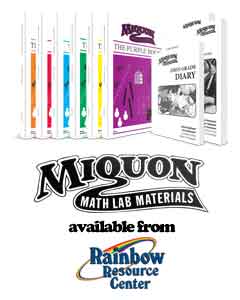About Miquon Math Labs
Miquon Math Labs is based on several observations:
- Often times, children are able to comprehend more than we expect them to.
- Children learn quickly and easily when there is a means to teach themselves.
- Children do not make senseless mistakes or random guesses if they are not pushed into making them.
- One should be cautious about typing a child as either a rapid learner or slow learner.
- When freedom of movement is accepted, work periods may be extended far beyond what has been recommended for the age group.
From the Introduction to Notes to Teachers:
Mathematical activity is a thought process in abstract relationships, growing out of human observation and experience in the physical world. It is a faculty which extracts patterns from specific problems and experiences and applies those patterns to the solution of other ?not yet understood? problems. The joy and excitement of mathematics lie in the discovery that many apparently unrelated problems have basically the same mathematical structure. Mathematical analysis, then, is one of man?s most powerful tools for understanding this unity.
A first step in mathematical analysis is to start with a simple idea that lends itself to concrete observation. Beyond this, however, man has devised mathematical symbols as more than a tool for recording his observations of the physical world. Through the preciseness and brevity of his symbolism, he can spotlight relationships so that they can be interpreted instantaneously. Word language, in contrast, appears slow and vague. Mathematical notation, although originating as a language for describing physical reality, takes on a life of its own and, through its clarity, suggests to the human mind new patterns in the physical world…

Too often, we have tended to underestimate the ability of small children to discover, understand, and use basic mathematical concepts from the beginning of their school experience.
? Lore Rasmussen

Too often, we have tended to underestimate the ability of small children to discover, understand, and use basic mathematical concepts from the beginning of their school experience. This error in judgment has been built into present mathematics curricula for the elementary school. Emphasis has been placed almost solely on arithmetical computation skills, largely learned by rote, thus sacrificing the delightful experience of teacher and children thinking abstractly about the relationships that hold this arithmetic together.
When the school-age child first comes to the teacher, he already has a storehouse of mathematically interpretable life experiences. These experiences are much more complex and complete than traditional first-grade arithmetic programs lead us to expect. The first-grader does lack the conventional mathematical vocabulary and symbolism to communicate his insight verbally or in writing. He needs to be helped in school to acquire these tools. However, this must be done with full utilization of his continuing mathematical thinking and intuition, and not as a replacement for them.
Notations such as numerals and operational symbols come alive only through the active human mind. Yet, arithmetic is often taught as if these symbols were the only way in which certain relationships can be expressed.
? Lore Rasmussen
Teaching mathematics to young children cannot be merely a situation of verbal dialogue. It must be a doing, discovering, puzzling-out situation in which children are guided to pose questions, as well as to answer them in a variety of ways.
These primary-grade materials are the result of one elementary school?s attempt to reshape its primary mathematics program. The materials grew out of daily teaching and were developed by the teacher and her assistant over a period of years. All of the materials have been tried out with six- and seven-year-olds and have been revised and edited with the help of the children. They were not developed to prove a point or to champion a preconceived method?except insofar as we learn children?s capabilities and interests directly from them.
Need Help?
Have questions about Miquon Math Labs or teaching math to your children? Contact one of Rainbow Resource’s friendly Homeschool Consultants (weekdays from 9am to 5pm Central):
1-888-841-3456
Rainbow Resource Center
Interested in more homeschool/educational resources and helpful information?



